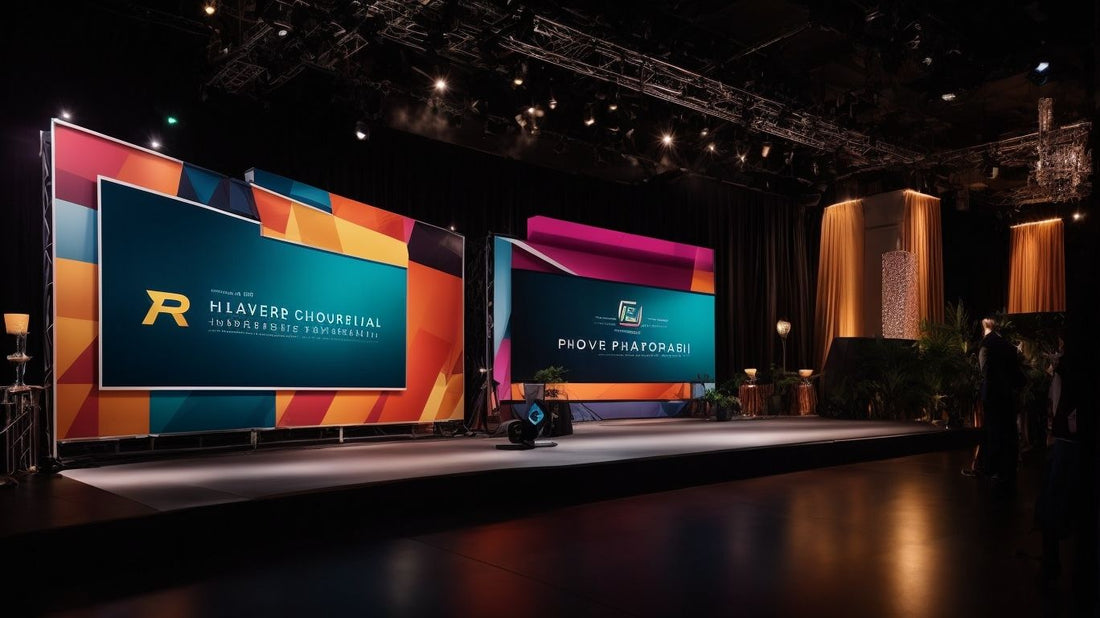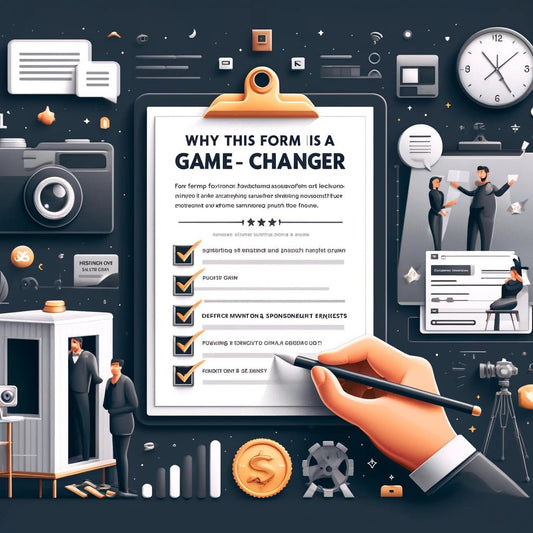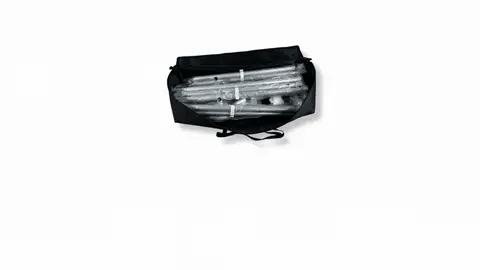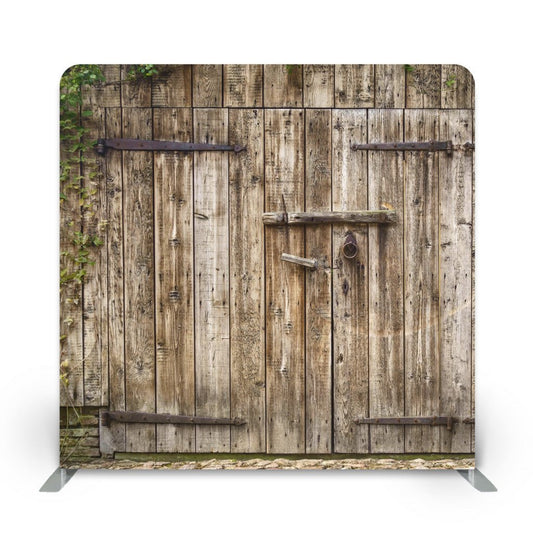
Unlocking Success through Effective Corporate Event Branding
Share
.jpg)
Corporate event branding plays a crucial role in creating a powerful and cohesive brand experience for attendees. It involves strategically incorporating brand elements and messaging into every aspect of an event to enhance brand awareness, establish a stronger brand identity, build trust and credibility, and create memorable and impactful experiences. Corporate event branding encompasses various key elements, such as logo and visual identity, consistent brand messaging, event theme and decor, and engaging and on-brand activities. To ensure successful corporate event branding, it is important to define event objectives and target audience, align event goals with brand values and personality, develop a comprehensive branding strategy, implement branding across all event touchpoints, and measure the effectiveness of branding. Looking at case studies of successful corporate event branding examples can provide valuable insights and inspiration. However, there are common challenges to overcome in corporate event branding, such as maintaining consistency across different event locations/formats, balancing branding with event creativity and innovation, and managing budget constraints and resource allocation. By addressing these challenges strategically, corporate event branding can effectively communicate a brand's values and leave a lasting impact on attendees.
What is Corporate Event Branding?
Corporate event branding refers to the process of creating a unique and consistent identity for a corporate event. It involves developing a distinct theme, logo, color scheme, and messaging that align with the company's values and objectives. Corporate event branding helps create a memorable experience for attendees and reinforces the company's brand image. It is essential for enhancing brand recognition, building client relationships, and establishing a professional reputation. To successfully implement corporate event branding, companies should consider their target audience, event goals, and desired outcomes. It is also crucial to maintain consistency across all event materials and communications to create a cohesive brand experience.
What is Corporate Event Branding?
Some suggestions for effective corporate event branding include:
| 1. Conducting thorough research on the target audience to understand their preferences and interests. | 2. Creating a visually appealing and cohesive brand identity that reflects company values. | 3. Incorporating the brand identity into event invitations, signage, marketing materials, and digital platforms. | 4. Providing immersive experiences that align with the brand and create a lasting impact on attendees. | 5. Incorporating interactive elements and technology to engage participants and enhance the overall event experience. |
|---|
By implementing these strategies, companies can effectively leverage corporate event branding to enhance brand awareness, foster meaningful connections, and achieve their event objectives.
The Importance of Corporate Event Branding
Corporate event branding is more than just a marketing tool – it's a powerful way to make a lasting impression. From boosting brand awareness to establishing a strong identity, corporate event branding plays a pivotal role. It builds trust, credibility, and creates memorable experiences that leave a lasting impact. With these sub-sections, we will dive into the significance of corporate event branding, exploring how it enhances brand awareness, establishes a stronger brand identity, builds trust and credibility, and creates impactful memories. Let's unfold the power of corporate event branding together!Enhances Brand Awareness
Enhancing brand awareness through corporate event branding is crucial. By creating a cohesive and memorable brand experience at events, companies can effectively promote their brand to a wider audience.
- One way to enhance brand awareness is by maintaining a consistent visual identity, using logos, colors, and graphics that align with the brand's overall aesthetic.
- Strategic brand messaging is another important aspect, ensuring that all event communication and content reinforce the brand's key messages and values.
- Engaging attendees through interactive activities and memorable experiences also contributes to brand awareness enhancement.
- Moreover, extending the reach of the event by leveraging social media and other promotional channels helps to create awareness beyond the event itself.
An exemplary case of successful brand awareness enhancement through corporate event branding is Apple's product launches. Through meticulously crafted events, Apple manages to generate immense hype and awareness around their new product releases, creating a buzz that extends far beyond the actual event.
Establishes a Stronger Brand Identity
Establishing a stronger brand identity is essential for corporate event branding. It not only helps differentiate a company from its competitors but also creates a lasting impression on attendees, which is crucial. Here are the key factors that contribute to the establishment of a stronger brand identity:
- Consistent Visual Identity: Utilize the company's logo, colors, and fonts consistently across all event materials and decor. This consistency is vital in establishing a stronger brand identity.
- On-Brand Messaging: Make sure that all event communications, including speeches and presentations, are in line with the company's brand values and tone. This alignment is an important part of establishing a stronger brand identity.
- Event Theme and Decor: Select a theme that reflects the company's values and incorporate it into the event's decor and ambiance. This integration contributes to establishing a stronger brand identity.
- Engaging Activities: Organize activities that resonate with the brand and provide opportunities for attendees to interact with the company's products or services. These activities play a significant role in establishing a stronger brand identity.
By integrating these elements, corporate event branding effectively establishes a stronger brand identity.
Builds Trust and Credibility
Building trust and credibility is crucial for corporate event branding. Here's a list of how it can be achieved:
- Consistent messaging: Ensure that your messaging aligns with your brand's values and communicates a consistent message to build trust and credibility with your audience.
- Transparency: Be transparent in your communications and provide accurate information about your event to build trust with your attendees and establish credibility.
- Deliver on promises: Follow through on your commitments and deliver on promises made during the event to establish trust and credibility.
- Engage with attendees: Create opportunities for attendees to interact with your brand and build relationships. This can include Q&A sessions or networking events that help build trust and credibility.
- Positive experiences: Focus on creating memorable and impactful experiences for attendees, as positive experiences foster trust and credibility, building trust and credibility for your brand.
Creates Memorable and Impactful Experiences
Memorable and impactful experiences are at the heart of successful corporate event branding. By incorporating immersive environments, interactive activities, innovative technology, personalized touches, and surprising moments, companies can create unique and engaging elements that leave a lasting impression on attendees.
- Immersive environments: Designing the event space to reflect the brand identity and theme enhances the overall experience.
- Interactive activities: Incorporating hands-on experiences, such as interactive booths or workshops, encourages active participation and engagement.
- Innovative technology: Utilizing cutting-edge technology, like virtual reality or augmented reality, creates memorable and impactful moments for attendees.
- Personalized touches: Tailoring elements of the event, such as branded giveaways or customized content, makes attendees feel valued and connected to the brand.
- Surprising moments: Unexpected or unique experiences, such as surprise performances or exclusive access, leave a memorable and impactful impression on attendees.
In a recent corporate event, a technology company created memorable and impactful experiences by transforming a traditional conference into an immersive virtual reality world. Attendees wore VR headsets and were transported to a futuristic environment, where they interacted with virtual exhibits and networked with avatars. This innovative approach not only aligned with the company's brand image but also generated buzz and excitement among participants, making it a truly unforgettable event.
Key Elements of Corporate Event Branding
Transforming a corporate event into an unforgettable brand experience requires careful consideration of key elements. In this section, we'll unlock the secrets behind successful corporate event branding. From crafting a captivating logo and visual identity to delivering consistent brand messaging, we'll explore the power of event themes, engaging activities, and on-brand décor. Get ready to dive into the world of corporate event branding and discover how these elements play a vital role in creating a lasting impact on attendees.Logo and Visual Identity
When it comes to corporate event branding, the logo and visual identity play a crucial role in creating a cohesive and memorable experience. Here are some key considerations:
- Design a logo that represents your brand's values and personality.
- Ensure consistent use of colors, fonts, and graphics across all event materials.
- Create visually appealing signage, banners, and stage set-ups that align with your brand aesthetic.
- Incorporate your logo and visual elements in event invitations, programs, and promotional materials.
- Use branded merchandise and giveaways to reinforce your logo and visual identity.
A great example of effective logo and visual identity use is the "Just Do It" campaign by Nike. The iconic swoosh logo, combined with bold and impactful visuals, helped establish Nike as a leading sports brand and created a strong brand identity that resonated with their target audience.
Consistent Brand Messaging
Consistent brand messaging is the key to successful corporate event branding. It is crucial for effectively communicating your brand's values, personality, and overall identity throughout the event. Here are some important considerations to achieve this goal:
- Define brand messaging: Clearly establish your brand's key messages and taglines that align with your overall brand strategy.
- Use consistent language: Maintain a uniform tone and voice in all event communications, including invitations, signage, and presentations.
- Align visuals with messaging: Ensure that visuals, such as logos, fonts, and colors, remain consistent with your brand's visual identity.
- Train staff: Provide comprehensive training to event staff to ensure they understand and embody your brand messaging when interacting with attendees.
By implementing and adhering to consistent brand messaging, you can create a cohesive and impactful event experience that reinforces your brand identity and resonates with attendees.
Event Theme and Decor
When it comes to corporate event branding, the Event Theme and Decor play a crucial role in creating a memorable and impactful experience. Here are some key considerations for selecting the right Event Theme and Decor:
- Align with brand identity: Choose a theme and decor elements that reflect your brand's personality and values.
- Cohesive and consistent: Ensure that the Event Theme and Decor elements are consistent with your brand's visual identity and messaging.
- Audience connection: Consider the preferences and interests of your target audience to create an immersive and engaging experience.
- Innovation and creativity: Find unique and innovative ways to incorporate the Event Theme and Decor elements that stand out and leave a lasting impression.
Fact: Studies have shown that incorporating a well-designed and cohesive Event Theme and Decor can significantly enhance brand perception and attendee satisfaction.
Engaging and On-Brand Activities
To ensure that your corporate event branding is engaging and on-brand, consider incorporating the following engaging and on-brand activities:
- Interactive Workshops: Organize hands-on sessions that align with your brand message, allowing attendees to actively participate and learn.
- Branded Games: Create custom games or activities that showcase your brand in a fun and interactive way, leaving a lasting impression on attendees.
- Themed Experiences: Design immersive experiences that reflect your brand's values and personality, transporting attendees into a world that aligns with your brand identity.
- Live Performances: Incorporate live entertainment or performances that resonate with your brand, using music, dance, or theater to engage and captivate attendees.
- Networking Opportunities: Facilitate networking sessions or interactive ice-breaker activities that encourage attendees to connect with each other and forge meaningful connections.
By incorporating these engaging and on-brand activities into your corporate event, you can create a memorable experience that reinforces your brand image and leaves a lasting impact on attendees.
Steps to Successful Corporate Event Branding
Planning a corporate event? Want to ensure your branding strategy is on point? Look no further! In this section, we'll uncover the key steps to successful corporate event branding. We'll dive into how to define your event objectives and target audience, align your event goals with your brand values and personality, develop a comprehensive branding strategy, implement branding across all event touchpoints, and measure the effectiveness of your branding efforts. Get ready to elevate your corporate event and leave a lasting impression on attendees. Let's dive in!Define Your Event Objectives and Target Audience
- Defining your event objectives and target audience is essential for successful corporate event branding. Follow these steps to assist you with this process:
- Identify your goals: Determine the specific objectives you aim to achieve through the event, such as promoting a new product, building brand awareness, or strengthening client relationships.
- Research your target audience: Understand your target demographic, their interests, preferences, and behavior. This understanding will help you customize your event to their needs and create a more engaging experience.
- Set measurable objectives: Clearly define measurable goals that align with your event objectives. This could involve metrics such as attendee satisfaction, lead generation, or social media engagement.
- Create audience personas: Develop comprehensive profiles of your target audience, including their demographics, interests, and pain points. These profiles will guide your event planning and enable you to customize the experience.
- Segment your audience: Divide your target audience into smaller segments based on shared traits. By doing this, you can create targeted messaging and experiences for different groups.
Align Event Goals with Brand Values and Personality
To effectively align event goals with the values and personality of your brand, the first step is to clearly define the core values and personality traits associated with your brand. This will serve as the solid foundation for determining the objectives of your corporate event. For instance, if your brand highly values innovation and creativity, your event goals should focus on showcasing groundbreaking ideas and creating interactive experiences for attendees.
Once you have identified the brand values and event goals, it is absolutely crucial to integrate them consistently throughout the entire planning and execution process of the event. This can be achieved through various strategies, such as carefully selecting a venue that embodies your brand's values, designing event materials that effectively represent the brand's visual identity, and curating activities and content that resonate with the brand's distinct personality.
By aligning the event goals with the brand values and personality, you will create a cohesive and authentic experience for attendees, resulting in the strengthening of your brand's identity and fostering a deeper connection with your target audience. The event becomes an extraordinary opportunity to demonstrate your brand's values and personality in action, leaving a memorable impression and reinforcing brand loyalty.
Develop a Comprehensive Branding Strategy
Developing a comprehensive branding strategy is crucial for successful corporate event branding.
Understand the event objectives and target audience to align the branding strategy with the overall goals.
Create a strong brand identity by incorporating consistent branding elements like logo, visual identity, and messaging.
Design the event theme and decor to reflect your brand's personality and values.
Engage attendees with activities that are on-brand and reinforce your brand message.
Implement branding across all event touchpoints, including signage, promotional materials, and social media.
Measure and evaluate the effectiveness of branding to make adjustments for future events.
In a similar context, a technology company organized a conference with a comprehensive branding strategy. They developed a comprehensive branding strategy by understanding the event objectives and target audience, which helped align the branding strategy with the overall goals. They also incorporated their logo, visual identity, and messaging consistently throughout the event. The event theme and decor were designed to reflect their brand's personality and values, creating an immersive experience for attendees. Engaging and on-brand activities, such as interactive tech demos, were implemented to reinforce their brand message. The success of the event was measured through attendee feedback and an increase in brand awareness post-event.
Implement Branding Across all Event Touchpoints
Implementing branding across all event touchpoints is essential to maintain consistency and reinforce brand identity. It is crucial to ensure that the event logo and visual elements align with the overall brand design. Consistent messaging throughout event materials, such as invitations, signage, and presentations, should be used. To create a cohesive and immersive experience, branding elements should be incorporated into the event theme and decor. Additionally, planning activities that align with the brand personality and values will help promote engagement and brand connection. By implementing branding across all event touchpoints, companies can create a unified brand experience that leaves a lasting impression on attendees.
Measure and Evaluate the Effectiveness of Branding
Measuring and evaluating the effectiveness of branding is of utmost importance when it comes to assessing the impact of corporate event branding strategies. It enables companies to gauge the return on investment and make well-informed decisions for future events. Key metrics for assessment encompass brand awareness, brand perception, attendee feedback, and engagement levels. Through surveys, social media analytics, and event registration data, companies can effectively track these metrics. Valuable insights can be gained by analyzing qualitative feedback and conducting post-event assessments. By undertaking effective measurement and evaluation of branding effectiveness, companies can refine their strategies, pinpoint areas for improvement, and maximize the impact of their corporate events.
Case Studies: Successful Corporate Event Branding Examples
- Successful corporate event branding examples, such as Google I/O, Apple's WWDC, and TED Conferences, can serve as case studies for companies looking to create a memorable and impactful event.
- Google I/O, the annual Google developer conference, is known for its innovative and immersive experiences. It incorporates cutting-edge technology and interactive displays to create a successful corporate event branding example.
- Apple's WWDC, the Worldwide Developers Conference, focuses on sleek and minimalistic design to reflect the company's brand image. This creates a cohesive and visually appealing event, serving as a case study for successful corporate event branding.
- TED Conferences, renowned for their thought-provoking talks, utilize a distinctive red circle stage that instantly conveys the TED brand. This creates a sense of anticipation and excitement, making it a successful corporate event branding example.
Common Challenges and How to Overcome Them
Overcoming common challenges in corporate event branding: maintaining consistency across various event locations/formats, striking a balance between branding and event creativity, and managing budget constraints and resource allocation. Let's uncover effective strategies and practical solutions to tackle these hurdles in order to ensure a successful and impactful brand presence in diverse corporate events.Consistency Across Different Event Locations/Formats
Consistency Across Different Event Locations/Formats is a critical aspect in achieving successful corporate event branding. To ensure this consistency, there are several key considerations to keep in mind:
1. Create a brand style guide that outlines the visual elements, such as logo usage, color palette, and fonts. This will guarantee that these elements are consistently applied across all event materials.
2. Develop a set of standardized event templates and formats that can be easily adapted to various locations and formats, while still maintaining the brand identity.
3. Establish clear communication channels between event organizers at different locations. This will ensure that they understand and follow the brand guidelines effectively.
4. Regularly monitor and review event materials from different locations. This will help identify any inconsistencies and take the necessary actions to rectify them promptly.
5. Provide comprehensive training and support to event staff to ensure that they are knowledgeable about the brand. This will enable them to implement the brand consistently throughout all events.
By prioritizing Consistency Across Different Event Locations/Formats, companies can strengthen their brand identity and create a unified experience for all attendees.
Balancing Branding with Event Creativity and Innovation
When planning a corporate event, it is crucial to strike a balance between balancing branding with event creativity and innovation. While branding helps establish a strong brand identity and build trust, creativity and innovation add excitement and engagement to the event. Here's how to maintain this balance:
1. Consistent Branding: Incorporate the brand's visual elements, messaging, and values throughout the event.
2. Creative Event Elements: Introduce unique and innovative elements that align with the brand's personality and objectives.
3. Cohesive Theme: Develop a theme that reflects the brand's identity while allowing room for creative and innovative event elements.
4. Collaborate: Work with event professionals who understand the importance of branding while bringing fresh and creative ideas to the table.
By balancing branding with event creativity and innovation, you can create an impactful and memorable corporate event that leaves a lasting impression on attendees.
Budget Constraints and Resource Allocation
Budget constraints and resource allocation are common challenges faced in corporate event branding. Limited funds and resources can impact the overall effectiveness and success of an event. Companies must find ways to maximize their budgets and allocate resources efficiently. This can be achieved by prioritizing essential elements of branding, such as logo and visual identity, consistent messaging, and engaging activities. Clear goals and a comprehensive branding strategy are crucial in making the most out of limited resources. Measurement and evaluation of branding efforts can also help identify areas for improvement and optimize future budget allocation.
During the economic recession of 2008, many companies faced severe budget constraints and had to carefully allocate their limited resources to stay afloat. This challenging period required strategic decision-making and creative problem-solving to ensure branding efforts continued despite financial limitations. Through smart budget management and resource optimization, companies were able to successfully maintain their brand presence and emerge stronger when the economy recovered.
Frequently Asked Questions
1. How can appreciation events help strengthen connections with current employees and future talent?
Appreciation events provide an opportunity for companies to show gratitude to their employees and build a positive company culture. By organizing enjoyable experiences, such as corporate summer parties or experiential activations, appreciation events create a sense of camaraderie and foster stronger connections among current employees. This positive atmosphere also helps attract and retain future talent, as it showcases the company's commitment to employee satisfaction and well-being.
2. How can branded entertainment contribute to building brand awareness and promoting a unique product?
Branded entertainment, such as incorporating interactive games or performances that align with the corporate event brand, can greatly enhance the event experience and engage attendees. This unique form of entertainment not only captivates the audience but also leaves a lasting impression related to the company and its products or services. By creating a memorable and enjoyable experience, branded entertainment helps to build brand awareness and promotes the unique features of a product or service, effectively setting the company apart from competitors.
3. What are some key elements to consider when securing a venue for a corporate event?
When securing a venue for a corporate event, several key elements should be taken into consideration. Firstly, the location should be easily accessible for attendees, with convenient transportation options. Secondly, the venue should have adequate space and facilities to accommodate the expected number of guests and the planned activities. Additionally, the venue should align with the desired ambiance and atmosphere of the event, reflecting the corporate event brand. Lastly, considering the technical requirements, such as audiovisual equipment and internet connectivity, is crucial for ensuring a successful event.
4. What are some refreshing sips and bold color palettes that can be incorporated into a corporate summer party?
For a corporate summer party, refreshing sips can include a variety of cold beverages such as fruit-infused water, iced teas, lemonades, or signature cocktails. As for bold color palettes, vibrant hues like citrus orange, tropical turquoise, or sunny yellow can be incorporated into the event's decorations, table settings, and even food presentations. These refreshing sips and bold color palettes create a lively and festive atmosphere, enhancing the overall enjoyment of the corporate summer party.
5. How can event branding turn a logo into an experience?
Event branding goes beyond simply displaying a logo; it transforms the logo into a full experience. By incorporating the logo into various aspects of the event, such as custom backdrops, signage, stationery, and digital presentations, attendees are continuously exposed to the corporate event brand. This immersive branding approach allows the logo to become an integral part of the event's narrative and visual identity, effectively turning it into a memorable and engaging experience for the attendees.
6. How can strong event branding help companies find new customers and speak directly to their target audience?
Strong event branding plays a vital role in attracting and engaging new customers. By consistently applying the corporate event brand in event materials, decorations, and experiences, companies create a unified and recognizable presence. This branding strategy helps to build brand awareness among the event attendees, who may be potential customers, and establishes a connection with the target audience. Additionally, by speaking directly to their target audience through targeted messaging and event experiences, companies can effectively communicate their unique value propositions and gain new customers in the process.






